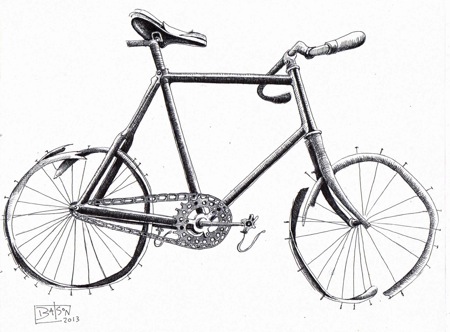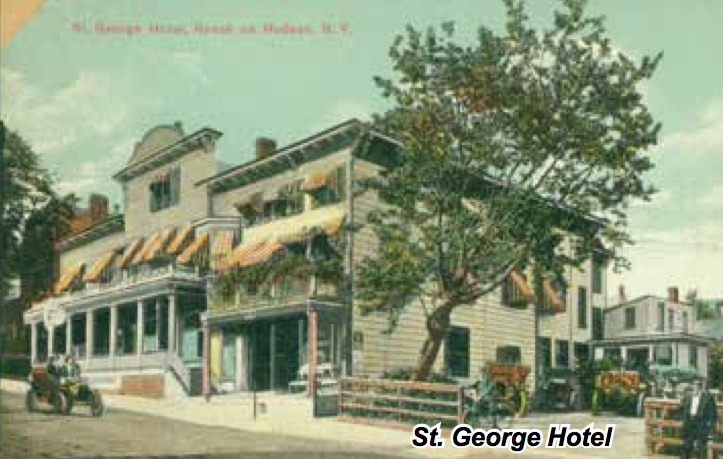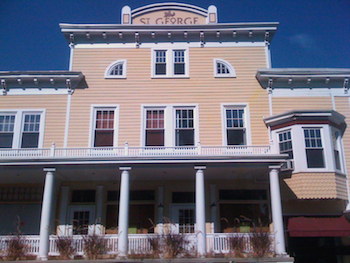The President Comes To Town;
Cyclists Fill The Streets; Nightly Noise From The Bars.
Feels like 1889 once again.
by Gini Stolldorf, Historical Society of The Nyacks
For most of the 1800s, Nyack was a destination. The Nyack Turnpike, completed in the 1820s, opened Rockland County from west to east with Nyack being the final destination in the eastern part of the county. The Northern Railroad that came through Nyack hastened its industrialization and prosperity and provided a convenient commute to New York City. There was also a ferry service at the foot of Burd Street. Nyack built hotels to accommodate people in transit and on holiday. The first, Mansion House, located on Main Street near Broadway, opened in 1822.
Nyack: Then & Now
The president came to Nyack in 1889. The president came to Tarrytown in 2014.
In 1885, the Rockland County Journal wrote about 30 cyclists coming to Nyack. During a busy weekend in 2014, the village gets as many as 5000 visiting cyclists from NYC.
An 1889 headline in the Rockland County Journal read: “Noise in Saloons.” Today, there’s Facebook.
Also “today” at the Historical Society of The Nyacks:
- Hammers, saws, chisels, planes and drills, and a sphygmomanometer and stethoscope — and their hidden stories. “A NYACK TOOLBOX – Implements from the Past,” is the current exhibit at the Historical Society of the Nyacks Museum, open weekends from 1-4p, 50 Piermont Avenue across the street from Memorial Park.
- “Berta and Elmer Hader – A Lifetime of Art,” is currently on display at the Nyack Library through November. The Grandview, NY couple illustrated over 100 books, including the Caldecott winning “The Big Snow.” John Steinbeck asked Elmer to illustrate the jacket covers for “The Grapes of Wrath”, East of Eden,” The Winter of our Discontent” and “The Long Valley.”
For more information, visit NyackHistory.org.
The village became a tourism and vacation destination offering dozens of hotels to travelers through World War I. By the 1870s, Nyack had become a resort for residents of New York City seeking cleaner air and water. They wished to escape the city air and spend time in the country by the Hudson. During this time, epidemics were quite common— measles, malaria, cholera, and influenza. People fled the city, especially during summer months, and stayed in Nyack’s hotels and boarding houses. Room rates were $1.50 to $2 a day with weekly rates of $8 (half price for children).
In July 1889, between terms as president, Grover Cleveland came to Nyack on the Northern Railroad and stayed at the Prospect House located on South Highland Avenue. When a reporter for the Rockland County Journal showed up to talk to Cleveland, he commented that “reporters are all over, wherever one goes, ready to jot down everything that happens.” Cleveland then proceeded to talk about his favorite hobby, fishing. Later on, the Democratic Club of Nyack held a rally in his honor and he spent the rest of the day talking with Nyack residents. He left the next morning by train.

A bike, with wooden wheels, belonging to American realist painter and Nyack native, Edward Hopper (1882-1967).Shirts with Hopper’s über-retro bike are available for purchase at the Edward Hopper House Art Center in Nyack.
Illustration Credit: ©2014 Bill Batson.
Bicycles were also a popular means of transportation from the 1860s to the early 1900s (see Edward Hopper’s bicycle at the Edward Hopper House on Broadway). In June 1885, the Rockland County Journal published an article reporting on a particular Sunday when over 30 bicyclists from New York City rode to Tarrytown, ferried across the river to Nyack, ate lunch at one of the numerous hotel restaurants, got back on the ferry to Tarrytown, retrieved their bicycles, and biked back to the city. The rapid development of the automobile caused many people to lose interest in cycling.
The hotels had dining and bar facilities, which caused problems with noise during the evening hours. On June 29, 1889, an article appeared in the Rockland County Journal titled: “Noise in Saloons,” which stated that a petition was St. George Hotel presented to the Board of Trustees of the Village of Nyack to take some action to compel hotels to close at midnight. Numerous complaints had been made that loud noises coming from some of the establishments, lasting until 2 and 3 o’clock in the morning, greatly disturbed the peace of the neighborhoods, preventing people from sleeping. The police were ordered by the Board to look into the matter and compel the hotels and saloons to close at midnight.
One hotel, located on North Broadway and Fourth Avenue, started out as Lydecker’s Boarding House and in 1892 was christened the Ivanhoe Hotel. The article in the Journal reported that fifty boarders and guests from the village gathered to rename the building. Three “ladies” from those in attendance who suggested names were chosen to make a selection from the list— it only took a few minutes to settle on the name Ivanhoe. In 1962, Samuel Eidelberg, builder of the current apartment building on the site, decided to retain the name in homage to its history.
 The St. George Hotel on Burd Street was under the ownership of George Bardin (1846-1909) for over 20 years. Bardin had previously managed a few other hotels in Nyack. Before he came to Nyack, Bardin had been the personal secretary to James “Diamond Jim” Fisk, a tarnished American financier who, along with Jay Gould, helped cause the collapse of the gold market on September 24, 1869, known as “Black Friday.” (Fisk was only 36 when the collapse occurred and shortly thereafter was fatally shot in New York City by a disgruntled associate.)
The St. George Hotel on Burd Street was under the ownership of George Bardin (1846-1909) for over 20 years. Bardin had previously managed a few other hotels in Nyack. Before he came to Nyack, Bardin had been the personal secretary to James “Diamond Jim” Fisk, a tarnished American financier who, along with Jay Gould, helped cause the collapse of the gold market on September 24, 1869, known as “Black Friday.” (Fisk was only 36 when the collapse occurred and shortly thereafter was fatally shot in New York City by a disgruntled associate.)
 From the time he purchased the St. George in 1886, Bardin wanted to make its restaurant one of the best along the Hudson. He was successful and it became Nyack’s Delmonico’s. Bardin was known to be a perfect gentleman, always courteous and polite. Many people thought that no one knew better than Bardin how to manage a first-class hotel and he was held in high esteem by the Nyack community. He was elected four times as Rockland County representative to the New York State Hotel Association. When Bardin died in August 1909, memorial services were held at St. Ann’s Church.
From the time he purchased the St. George in 1886, Bardin wanted to make its restaurant one of the best along the Hudson. He was successful and it became Nyack’s Delmonico’s. Bardin was known to be a perfect gentleman, always courteous and polite. Many people thought that no one knew better than Bardin how to manage a first-class hotel and he was held in high esteem by the Nyack community. He was elected four times as Rockland County representative to the New York State Hotel Association. When Bardin died in August 1909, memorial services were held at St. Ann’s Church.
By the 1930s, most of Nyack’s hotels had closed as the automobile broadened people’s choices of vacation destinations.
See also: New Yorkers And Their Bicycles: 1869 Edition, 8/16/2013
This article originally appeared in the Fall-Winter edition of the Historical Society of The Nyacks Newsletter. For more information on the HSN, visit NyackHistory.org.








